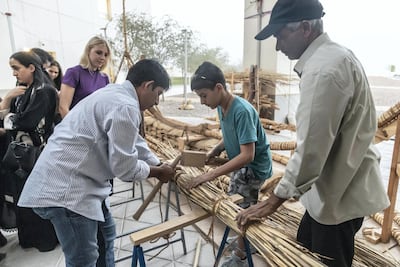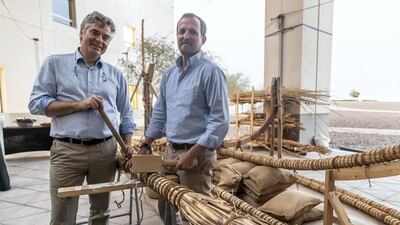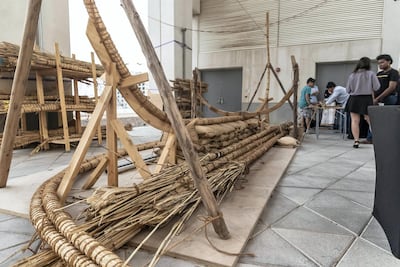In the Bronze Age, maritime trade in the Gulf was revolutionised by the invention of boats capable of shipping goods hundreds of miles.
About 4,000 years later, academics and university students have launched an ambitious attempt to build a working reconstruction of the type of vessel that, for the first time in history, could sail from what is now Iraq, through the Arabian Gulf, reaching as far as the coastline of India
A lack of physical remains mean little is conclusively known about the structures of the first boats capable of long-distance travel, with the natural materials used to build them having long since disintegrated.
But experts are using a combination of historical sources, including miniature models found in graves and a “shopping list” of items etched into an ancient stone tablet, to recreate an eight-metre-long vessel that they hope will prove seaworthy.
It is hoped that the project, launched in a collaboration between New York University Abu Dhabi and Zayed University, will be completed within a year. Construction is already under way, and it is hoped that it will lead to a greater understanding of a crucial development in human history.

“We are exploring the origins of long-distance trade in the region, which we really saw develop in the Bronze Age in the Gulf and into the Indian Ocean, connecting Mesopotamia and the Indus Valley,” said Eric Staples, assistant professor at Zayed University and co-director of the boat project.
“This was a commercial revolution. It required ships that could actually make the voyage and carry goods there and back. This is about exploring the maritime technology at the time, considering different sets of evidence to solve the puzzle of what a vessel might have looked like.
“Actually building a boat is an excellent way of gaining further information about these vessels, considering the limited evidence we have. You’re forced to confront and analyse the evidence in much greater depth and detail than you otherwise would, and re-examine your assumptions.”
It is believed that the crescent-shaped boats would have been directed with a single steering oar. A sail would have been made out of goat hair or a form of natural matting. Two expert boat builders have been brought in to assist with the project, which has been going on for a year, and about 80 students have already contributed to.
Bitumen, used for waterproofing, reeds and natural wood found in the region are among the other materials that will be used.
It is hoped that by early next year the boat will be ready to be tested in the water, and, if successful, it could even set sail on a long voyage, although its primitive nature means extensive safety measures would have to be in place. International museums have already shown an interest in displaying the completed replica.
“It wouldn’t have been the safest, let’s put it that way,” Dr Staples said. “This is the earliest origins of what you would call long-distance boat technology, so inevitably there were problems. By modern standards, it would be considered dangerous, although we don’t have exact mortality figures.”
The boat project is part of a wider drive to improve understanding of the UAE's maritime heritage, with the Middle East seen as a crossroads of civilisations for centuries. For thousands of years, the coastline of the country has been a key mercantile route.
New efforts are under way to learn far more about the UAE’s history by exploring under the sea, said Robert Parthesius, who is also co-director of the boat project.
A course he teaches at NYUAD, Shipwrecks and Seascapes, introduces students to maritime archaeology.
“I think we know the orbits now much better than the ocean,” Dr Parthesius said. “The places that are still to be discovered are underwater. We are looking now at rising sea levels as a big issue. The Gulf faced the same problem 15,000 years ago and a lot of communities that were living on the banks of rivers are now on the sea floor.
“There was a migration that took place, so the biggest discoveries about the culture of this country are still to be made underwater.
“Heritage is an important component of the UAE's national identity. Learning more and getting a richer understanding of the maritime connections of this country will enrich that.”


